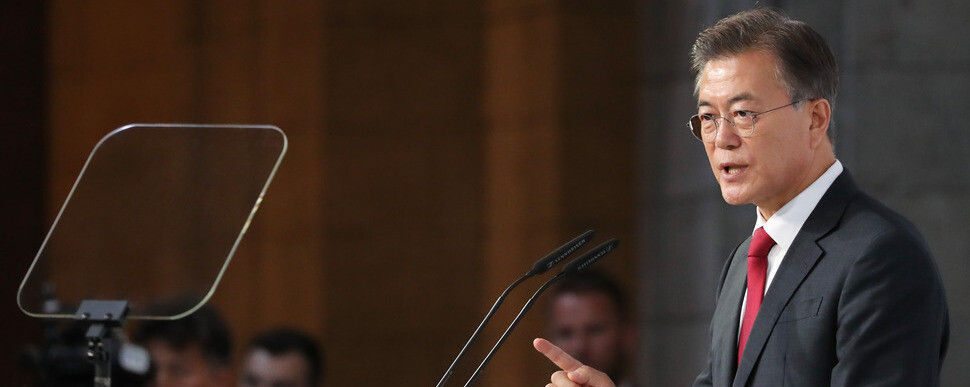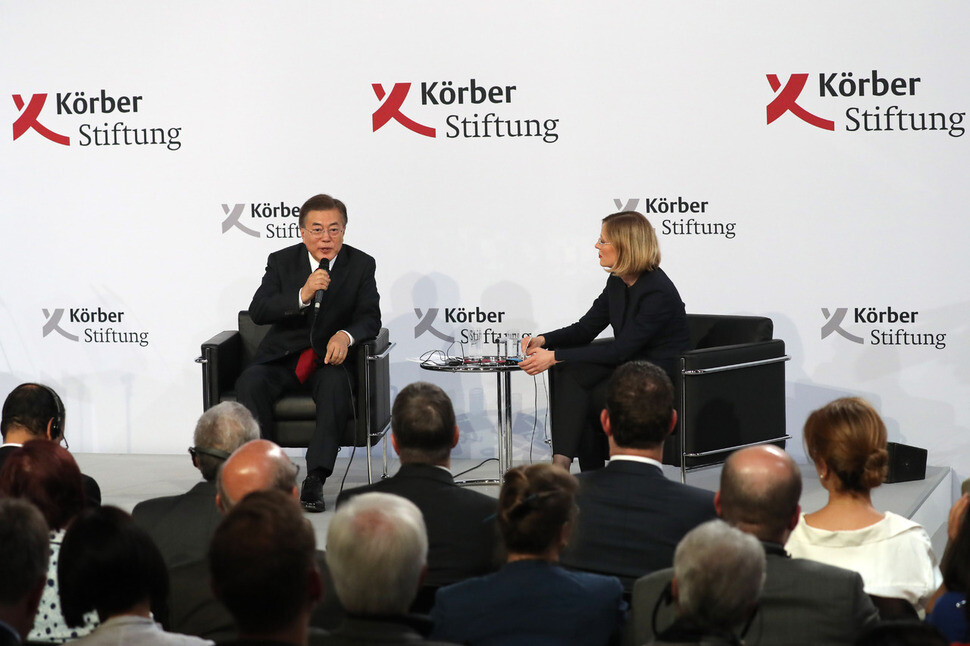hankyoreh
Links to other country sites 다른 나라 사이트 링크
In Berlin, President Moon lays out vision for inter-Korean peace

President Moon Jae-in proclaimed a vision for peace in Berlin on July 6, calling for the achievement of the Korean Peninsula’s denuclearization through peaceful means.
Moon said his aim was to “begin the bold journey of establishing a peace regime on the Korean Peninsula, with the Republic of Korea playing more of a guiding role.”
As a first step, Moon identified five “policy directions for dismantling the Cold War framework on the Korean Peninsula and establishing permanent peace” - including guaranteeing the security of the regime in Pyongyang with the peninsula’s denuclearization - and proposed four “tasks for practice” to the North as a means of breaking through, including the resumption of inter-Korean dialogue and reunions of divided families.
“The complete, verifiable, and irreversible denuclearization of the Korean Peninsula is a demand shared by the international community and an absolute prerequisite for peace on the Korean Peninsula,” Moon said in the speech, given in Berlin at the invitation of the Körber Foundation that afternoon.
“The need for dialogue is more urgent than ever before at a time like now when the vicious cycle of military tensions has reached a critical point,” he said.
Moon also said it was “important that the basic conditions have been put in place for restarting the halted Korean Peninsula peace process.”
“Recently, South Korea and the US agreed on a general approach in which sanctions are a diplomatic approach and denuclearization of Korean Peninsula is achieved through peaceful means,” he explained.
The “vision for peace on the Korean Peninsula” shared by Moon was both a summary of his ideas for North Korea policy and a blueprint for a peaceful future for the Korean Peninsula. It was a reflection of his longstanding ambitions of ending the Cold War-era framework on the peninsula through peaceful denuclearization and a peace regime, while using inter-Korean reconciliation to bring about a united economic community and pave the way for a future of branching out into Northeast Asia.
In his speech, Moon gave a three-principle approach to North Korea policy ruling out efforts to hasten a regime collapse in Pyongyang, unification by South Korean absorption of the North, or artificial efforts to accelerate reunification. Moon also sternly criticized North Korea’s recent intercontinental ballistic missile (ICBM) launch as an “extremely disappointing and very misguided decision.”
“North Korea’s choice this time is a reckless one. It has invited retaliation from the international community,” he said.
At the same time, he also stressed that “the need for dialogue is more urgent than ever before at a time like now when the vicious cycle of increasing military tensions has reached a critical point.”
“We do not wish for North Korea’s collapse, we will not pursue unification by absorption in any form, nor will be pursue artificial unification,” he said.
Moon also emphasized that Seoul and Washington had “recently declared that we do not hold hostile policies against North Korea.”
“Reunification will happen naturally at some point based on agreement between South and North once peace has been established,” he said. The message was that Moon plans to continue on with the so-called “four nos” approach he advocated at the recent South Korea-US summit, which took place before North Korea’s ICBM launch.
Moon went on to identify five “keywords” for North Korean policies toward ending the Cold War framework and establishing permanent peace: “peace,” “denuclearization,” “peace regime,” “new economic map,” and “exchange and cooperation.”

Moon’s peace proposal based on four “nos”
First, Moon stressed that “what we [South Korea] are pursuing is peace, pure and simple.”
“A peaceful Korean Peninsula is a Korean Peninsula where South and North acknowledge and respect each other and prosper together without threat of nuclear weapons or war,” he said.
Moon also said the path toward a peaceful peninsula lay in “returning to the June 15 Joint Declaration [of 2000] and the October 4 Summit Statement [of 2007].” Pyongyang emphasized execution of the declaration and statement every time difficulties arose in inter-Korean relations during the Lee Myung-bak (2008-13) and Park Geun-hye (2013-16) administrations. Moon’s explicit reference to their execution appeared to his answer to that demand.
Second, Moon said he would “pursue denuclearization of the Korean Peninsula that guarantees the security of the North Korean regime.”
Observing that the North Korean nuclear issue has become “far more advanced and complex than before,” he stressed that it would require a “step-by-step, comprehensive approach.”
Moon has stressed the importance of a two-step approach numerous times in the past, with a nuclear freeze as the entry point and denuclearization as the exit. He also stated plans to “work on comprehensively addressing Korean Peninsula and Northeast Asia issues including the complete dismantling of North Korea’s nuclear program, building a peace regime, allaying North Korea’s security and economic concerns, and improving North Korea-US and North Korea-Japan relations.”
Third, Moon emphasized establishment of a permanent peace regime and “institutionalization of peace.” To do this, he proposed legislation of inter-Korean agreement terms, a declaration of the Korean War’s end, and the signing of a Korean Peninsula peace agreement with the participation of relevant countries. With this, he sent the message that if North Korea denuclearizes, he plans to take simultaneous steps toward institutionally dismantling the peninsula’s Cold War-era systems. He repeatedly stressed his plans to “pursue total denuclearization and the signing of a peace agreement through a comprehensive approach to North Korean nuclear issues and a peace regime.”
Fourth, Moon also made reference to the “new economic map” for the Korean Peninsula that he previously proposed in Aug. 2015 as his vision if he eventually came to power.
“Once the North Korean nuclear issue has been resolved and suitable conditions are formed, we will begin drawing a new economic map,” he said.
He explained this would involve “restoring a new connection between South and North through an economic belt at the Military Demarcation Line and achieving an economic community where South and North prosper together.”
Moon has envisioned an inter-Korean economic community as a means of helping the South Korean economy recover from its loss of growth momentum.
Finally, Moon said he planned to “consistently pursue non-political exchange and cooperation efforts while keeping the political and military situations separate.”
“Ahead of interchange between governments, interchange at the private level has contributed [in the past] to relaxing inter-Korean tensions and restoring similarity,” he said.
“Greater private interchange will be an invaluable force freeing inter-Korean relations from their freeze,” he added.
The remarks marked a first practical step toward achieving Moon’s overall vision of North Korea’s denuclearization, followed by establishment of a peace regime and creation of a new economy for the peninsula.
By Jung In-hwan, staff reporter
Please direct questions or comments to [english@hani.co.kr]

Editorial・opinion
![[Guest essay] The real reason Korea’s new right wants to dub Rhee a founding father [Guest essay] The real reason Korea’s new right wants to dub Rhee a founding father](https://flexible.img.hani.co.kr/flexible/normal/500/300/imgdb/original/2024/0423/8317138574257878.jpg) [Guest essay] The real reason Korea’s new right wants to dub Rhee a founding father
[Guest essay] The real reason Korea’s new right wants to dub Rhee a founding father![[Column] ‘Choson’: Is it time we start referring to N. Korea in its own terms? [Column] ‘Choson’: Is it time we start referring to N. Korea in its own terms?](https://flexible.img.hani.co.kr/flexible/normal/500/300/imgdb/original/2024/0423/3617138579390322.jpg) [Column] ‘Choson’: Is it time we start referring to N. Korea in its own terms?
[Column] ‘Choson’: Is it time we start referring to N. Korea in its own terms?- [Editorial] Japan’s rewriting of history with Korea has gone too far
- [Column] The president’s questionable capacity for dialogue
- [Column] Are chaebol firms just pizza pies for families to divvy up as they please?
- [Column] Has Korea, too, crossed the Rubicon on China?
- [Correspondent’s column] In Japan’s alliance with US, echoes of its past alliances with UK
- [Editorial] Does Yoon think the Korean public is wrong?
- [Editorial] As it bolsters its alliance with US, Japan must be accountable for past
- [Guest essay] Amending the Constitution is Yoon’s key to leaving office in public’s good graces
Most viewed articles
- 1[Column] ‘Choson’: Is it time we start referring to N. Korea in its own terms?
- 2Why Korea shouldn’t welcome Japan’s newly beefed up defense cooperation with US
- 3Senior doctors cut hours, prepare to resign as government refuses to scrap medical reform plan
- 4[Guest essay] The real reason Korea’s new right wants to dub Rhee a founding father
- 5Opposition calls Yoon’s chief of staff appointment a ‘slap in the face’
- 6[Column] The clock is ticking for Korea’s first lady
- 7Terry Anderson, AP reporter who informed world of massacre in Gwangju, dies at 76
- 8New AI-based translation tools make their way into everyday life in Korea
- 9Samsung barricades office as unionized workers strike for better conditions
- 10Korea ranks among 10 countries going backward on coal power, report shows